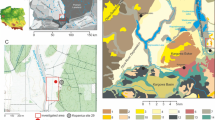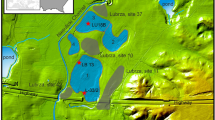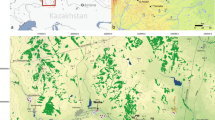Abstract
The large fortified hilltop site of Vladař, northwest Bohemia, Czech Republic (50°05′N, 13°13′E), has recently been studied intensively by way of environmental archaeology, in which palaeoecological methods have played a crucial role. The latter include the analyses of pollen, green algae, Cladocera, other microfossils, plant macro-remains (including charcoal and wood) and chemical composition, carried out on the wet sediments from an artificial cistern/pond situated in the middle of the large citadel, supplemented by charcoal and wood analysis on material from dry situations. The continuous palaeoecological record consists of well-preserved biological remains and covers the period from ca. 400 b.c. to recent times. The chronology is primarily based on radiocarbon dating, supplemented by archaeological finds. The main focus is on the La Tène period of the Iron Age. During the early to middle La Tène the hillfort had a considerable number of permanent inhabitants and woodland was almost completely replaced by an agricultural landscape. The site became partly abandoned by the end of the 3rd century b.c. and completely abandoned around the birth of Christ, after which it reverted to natural woodland communities.














Similar content being viewed by others
References
Behre K-E (1992) The history of rye cultivation in Europe. Vegetat Hist Archaeobot 1:141–156
Beug H-J (2004) Leitfaden der Pollenbestimmung für Mitteleuropa und angrenzende Gebiete. Pfeil, München
Birks HJB, Line JM, Persson T (1988) Quantitative estimation of human impact on cultural landscape development. In: Birks HH, Birks HJB, Kaland PE, Persson T (eds) The cultural landscape–past, present and future. Cambridge University Press, Cambridge, pp 229–240
Boenke N (2005) Organic resources at the Iron-Age Dürrnberg salt-mine (Hallein Austria)–Long-distance trade or local sources? Archaeometry 47:471–483
Bradley RS (1999) Palaeoclimatology; reconstructing climates of the Quaternary. 2nd edn. Harcourt Academic Press, San Diego
Břízová E (1997) Rekonstrukce vývoje vegetace a přírodních poměr ů v nivě Labe mezi Nymburkem a Mělníkem na základě pylové analýzy. (Reconstruction of the vegetation development and natural conditions at the river Labe floodplain between Nymburk and Mělník, based on pollen analyses. In Czech.) In: Dreslerová D (ed), Osídlení a vývoj holocénní nivy Labe mezi Nymburkem a Mělníkem. Grantová agentura ČR, final report, depon. Archeologický ústav AVČR, Praha
Chytráček M (2002) Südwestböhmen im überregionalen Verkehrsnetz der Hallstatt- und Frühlatènezeit. In: Chytráček M, Michálek J, Schmotz K (eds) Archäologische Arbeitsgemeinschaft Ostbayern/West- und Südböhmen, 11. Treffen 20. bis 23. Juni 2001 in Obernzell. Leidorf, Rahden/Westf, pp 121–142
Chytráček M, Metlička M (2004) Die Höhensiedlungen der Hallstatt- und Latènezeit in Westböhmen. Mit Beiträgen von Petr Pokorný und René Kyselý. Památky archeologické, Supplementum 16, Praha
Frey DG (1986) Cladocera analysis. In: Berglund BE (ed) Handbook of Holocene palaeoecology and palaeohydrology. Wiley, New York, pp 667–692
Frey OH (1996) Zu den figürlichen Darstellungen aus Waldalgesheim. In: Stöllner T (ed) Europa celtica–Untersuchungen zur Hallstatt- und Latènekultur. Leidorf, Rahden/Westf, pp 95–115
Grosser D (1977) Die Hölzer Mitteleuropas. Ein mikroskopischer Lehratlas. Springer, Berlin
Herrmann FR (1997) Die steinernen Statuen. Ein frühkeltischer Fürstengrabhügel am Glauberg im Wetteraukreis, Hessen. Germania 75:459–550
Herrmann FR (2002) Der Glauberg. Fürstensitz, Fürstengräber und Heiligtum. In: Baitinger H, Pinsker B (eds) Glaube—Mythos—Wirklichkeit. Das Rätsel der Kelten vom Glauberg. Stuttgart, pp 90–107
Krause R (2002) Ein frühkeltischer Fürstensitz auf dem Ipf am Nördlinger Ries. Antike Welt, Zeitschrift für Archäologie und Kulturgeschichte 33/5:493–508
Lobisser W (2005) Die eisenzeitlichen Bauhölzer der Gewerbesiedlung im Ramsautal am Dürrnberg bei Hallein. Dürrnberg-Forschungen 4. Leidorf, Rahden/Westf
Pokorný P (2002) Palaeogeography of forest trees in the Czech Republic around 2000 BP: Methodical approach and selected results. Preslia 74:235–246
Pokorný P (2004) Vegetation. In: Chytráček M, Metlička M (eds) Die Höhensiedlungen der Hallstatt- und Latènezeit in Westböhmen. Památky archeologické—Supplementum 16, Prague, pp 7–9
Pokorný P (2005) The effect of local human-impact histories on the development of Holocene vegetation. Case studies from Central Bohemia. In: Gojda M (ed) Ancient landscape, settlement dynamics and non-destructive archaeology. Czech Research Project 1997–2002. Academia, Praha, pp 171–185
Schweingruber FH (1976) Prähistorisches Holz: die Bedeutung von Holzfunden aus Mitteleuropa für die Lösung archäologischer und vegetationskundlicher Probleme. Haupt, Bern
Schweingruber FH (1990) Mikroskopische Holzanatomie. Anatomie microscopique du bois. Microscopical wood anatomy. Structural variability of stem and twigs in recent and subfossil woods from central Europe. Swiss Federal Institute Forest Reservation Birmensdorf, Edition Zürcher, Zug
Stöllner T (2002) Die Hallstattzeit und der Beginn der Latènezeit im Inn-Salzach-Raum. Archäologie in Salzburg 3/1,2. Salzburg
Szeroczynska K (2002) Human impact on lakes recorded in the remains of Cladocera (Crustacea). Quat Internat 95/96:165–174
Tomedi G (2002) Das hallstattzeitliche Gräberfeld von Frög (Kärnten). Die Altgrabungen von 1883 bis 1892. Archaeolingua 14, Budapest
Veselý J (2000a) The history of metal pollution recorded in the sediments of the Bohemian Forest lakes: since the Bronze Age to the present. Silva Gabreta 4:147–166
Veselý J (2000b) Sedimentary deposits of Bohemian Forest lakes as an archive of pollution by metals. GeoLines 11:54–56
Walanusz A, Nalepka D (1999) POLPAL program for counting pollen grains, diagrams plotting and numerical analysis. Acta Palaeobot Suppl 2:659–661
Acknowledgements
The authors wish to express their deepest respect for Brigitta Ammann. Her professional and personal interest has become a great stimulus for the development of contemporary Czech palaeoecology.
During preparation of this article we received great help from Pim van der Knaap and J. Greig who both made our text more concise and readable. We also thank K.-E. Behre and an anonymous reviewer for their perceptive reviews. We wish to give special thanks to L. Šmejda, M. Hajnalová, M. Kaplan, and A. Bieniek for sharing their ample knowledge and interest in this research. Our students and colleagues R. Kozáková, L. Petr, R. Haluzík, P. Loucká, L. Šmahelová, A. Danielisová, J. Matyášek, M. Dufková, R. Malát, and many others who helped during the excavations are greatly acknowledged. The members of the Civic Association “Vladař” are greatly acknowledged for their enthusiastic support during excavation campaigns. The study was carried under the subsidies of the grant project of the Grant Agency of the Academy of Sciences of the Czech Republic no. IAA8002204 and projects of the Ministry of Education nos. AV0Z80020508 and 0021620828.
Author information
Authors and Affiliations
Corresponding author
Additional information
Communicated by Pim van der Knaap
Rights and permissions
About this article
Cite this article
Pokorný, P., Boenke, N., Chytráček, M. et al. Insight into the environment of a pre-Roman Iron Age hillfort at Vladař, Czech Republic, using a multi-proxy approach. Veget Hist Archaeobot 15, 419–433 (2006). https://doi.org/10.1007/s00334-006-0064-8
Received:
Accepted:
Published:
Issue Date:
DOI: https://doi.org/10.1007/s00334-006-0064-8




